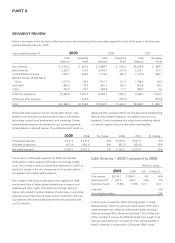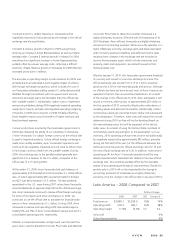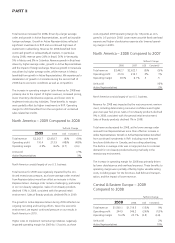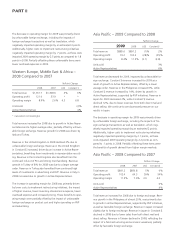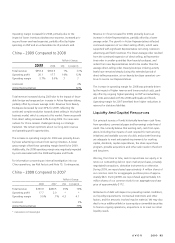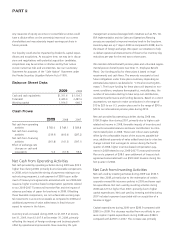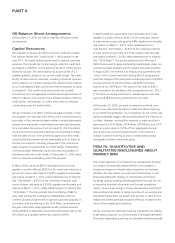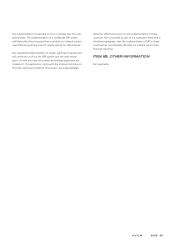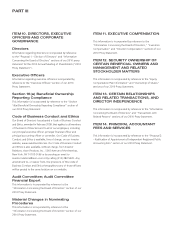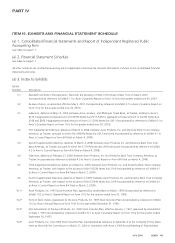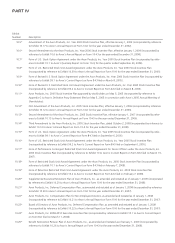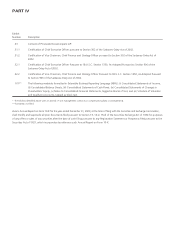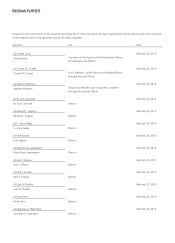Avon 2009 Annual Report Download - page 54
Download and view the complete annual report
Please find page 54 of the 2009 Avon annual report below. You can navigate through the pages in the report by either clicking on the pages listed below, or by using the keyword search tool below to find specific information within the annual report.PART II
Off Balance Sheet Arrangements
At December 31, 2009, we had no material off-balance-sheet
arrangements.
Capital Resources
We maintain afive-year, $1,000.0 revolving credit and competi-
tive advance facility (the “credit facility”), which expires in Jan-
uary 2011. The credit facility may be used for general corporate
purposes. The interest rate on borrowings under this credit facil-
ity is based on LIBOR or on the higher of prime or 1/2% plus the
federal funds rate. The credit facility has an annual fee of $.7,
payable quarterly, based on our current credit ratings. The credit
facility contains various covenants, including afinancial covenant
which requires our interest coverage ratio (determined in relation
to our consolidated pretax income and interest expense) to equal
or exceed 4:1. The credit facility also provides for possible
increases by up to an aggregate incremental principal amount of
$250.0, subject to the consent of the affected lenders under the
credit facility. At December 31, 2009, there were no amounts
outstanding under the credit facility.
We also maintain a$1,000.0 commercial paper program. Under
this program, we may issue from time to time unsecured promis-
sory notes in the commercial paper market in private placements
exempt from registration under federal and state securities laws,
for acumulative face amount not to exceed $1,000.0 outstand-
ing at any one time and with maturities not exceeding 270 days
from the date of issue. The commercial paper short-term notes
issued under the program are not redeemable prior to maturity
and are not subject to voluntary prepayment. The commercial
paper program is supported by our credit facility. Outstanding
commercial paper effectively reduces the amount available for
borrowing under the credit facility. At December 31, 2009, there
were no amounts outstanding under this program.
In March 2009, we issued $850.0 principal amount of notes
payable in apublic offering. $500.0 of thenotes bear interest at a
per annum coupon rate equal to 5.625%,payable semi-annually,
and mature on March 1, 2014, unless redeemed prior to maturity
(the “2014 Notes”).$350.0 of thenotes bear interest at aper
annumcoupon rate equal to 6.500%,payable semi-annually, and
mature on March 1, 2019, unless redeemed prior to maturity (the
“2019 Notes”). The net proceeds from theoffering of $837.6
were used to repay theoutstanding indebtedness under our
commercial paper program and forgeneral corporate purposes. In
connection with theoffering of the 2014 Notes, we entered into
five-year interest-rate swap agreements with notional amounts
totaling $500.0toeffectively convert thefixed interest rate on the
2014 Notes to avariable interest rate, based on LIBOR.
In March 2008, we issued $500.0 principal amount of notes
payable in apublic offering. $250.0 of the notes bear interest
at aper annum coupon rate equal to 4.8%, payable semi-annually,
and mature on March 1, 2013, unless redeemed prior to
maturity (the “2013 Notes”). $250.0 of the notes bear interest
at aper annum coupon rate of 5.75%, payable semi-annually,
and mature on March 1, 2018, unless redeemed prior to maturity
(the “2018 Notes”). The net proceeds from the offering of
$496.3 were used to repay outstanding indebtedness under our
commercial paper program and for general corporate purposes.
In August 2007, we entered into treasury lock agreements (the
“locks”) with notional amounts totaling $500.0 designated as
cash flow hedges of the anticipated interest payments on $250.0
principal amount of the 2013 Notes and $250.0 principal
amount of the 2018 Notes. The losses on the locks of $38.0
were recorded in accumulated other comprehensive loss. $19.2
of the losses are being amortized to interest expense over five
years and $18.8 are being amortized over ten years.
At December 31, 2009, we were in compliance with all cove-
nants in our indentures (see Note 4, Debt and Other Financing,
to our 2009 Annual Report). Such indentures do not contain any
rating downgrade triggers that would accelerate the maturity of
our debt. However, we would be required to make an offer to
repurchase the 2013 Notes, 2014 Notes, 2018 Notes, and 2019
Notes at aprice equal to 101% of their aggregate principal
amount plus accrued and unpaid interest in the event of a
change in control involving us and acorresponding ratings
downgrade to below investment grade.
ITEM 7A. QUANTITATIVE AND
QUALITATIVE DISCLOSURES ABOUT
MARKET RISK
The overall objective of our financial risk management program
is to reduce the potential negative effects from changes in
foreign exchange and interest rates arising from our business
activities. We may reduce our exposure to fluctuations in cash
flows associated with changes in interest rates and foreign
exchange rates by creating offsetting positions through the use
of derivative financial instruments and through operational
means. Since we use foreign currency rate-sensitive and interest
rate-sensitive instruments to hedge aportion of our existing and
forecasted transactions, we expect that any loss in value for the
hedge instruments generally would be offset by increases in the
value of the underlying transactions.
We do not enter into derivative financial instruments for trading
or speculative purposes, nor are we aparty to leveraged derivatives.
The master agreements governing our derivative contracts generally




